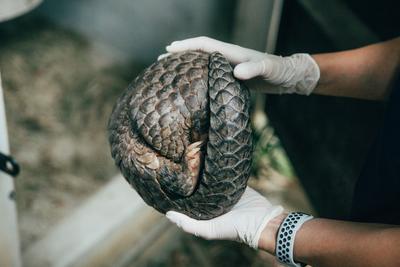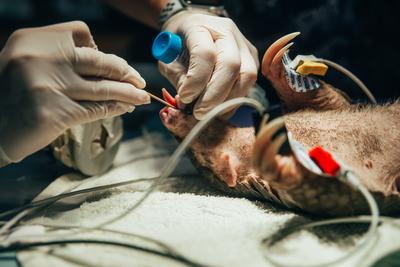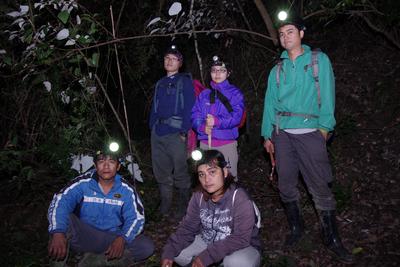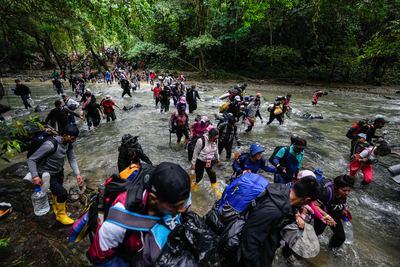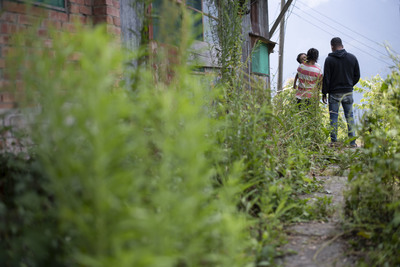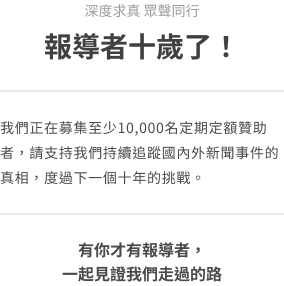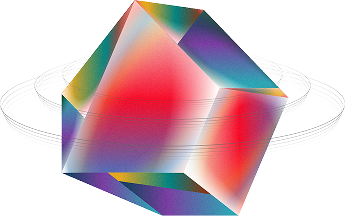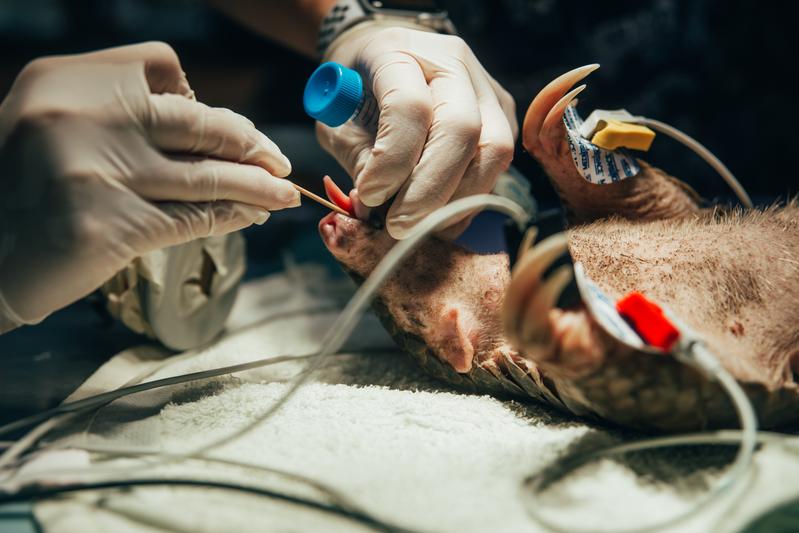
Pangolins are the most trafficked mammal on earth. If they happen to escape a hunter's wrath and get sent to a rescue center, they would still have a hard time surviving stomach ulcer and internal bleeding due to its nervous nature and particular dietary habits.
Keeping captive pangolins alive, then, became one of the most challenging missions. Taiwan, however, has become the most experienced pangolin conservationist in the world in the past two decades. Even teams from Hong Kong, Japan, and Germany came to gather knowledge from the pangolin experts in Taiwan.
How has Taiwan accumulated its successful experience? What kind of challenges is Taiwan still facing in pangolin conservation?
In the Taipei Zoo, one can find the most cheery pangolins at 3 p.m. every afternoon. When the clock strikes, three pangolins that are normally slow-moving would instantly and swiftly climb up the tree branches and stare at the acrylic food container — an act to remind the caregivers: it is time for lunch.
In the dim-lit pangolins conservation area, Formosan Animal Area Research Assistant Lo Hsuan-yi (羅諠憶) introduced the pangolin members to us from behind the glass.
“This is Cough Drop, that is Berry, and that one is Wukong — Wukong is the child of Chiung-wu (the pangolin that was born in the zoo in 2014),” she said. “These three were all born in 2017 and we were ecstatic about the fact that captive pangolins can produce offspring too.”
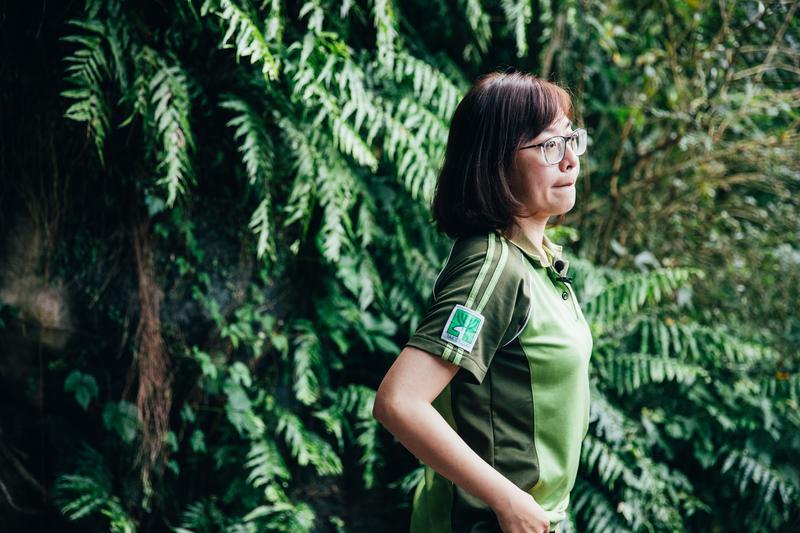
Lo's excitement about pangolin births came with a history.
She was the first “pangolin nanny” at Taipei Zoo, with over five years of experience in studying pangolins. In 2014, the zoo released a photo of the palm-sized baby pangolin Chiung-wu being held in Lo's hands. Chiung-wu was sucking on the tube feeder with squinty eyes, and her cute appearance had scored many pages of media coverage.
Chiung-wu's birth elevated Taiwan's global status in pangolin conservation. Before then, the world rarely saw anyone artificially nursing an infant pangolin. Chiung-wu was the first case where a pangolin was bred in captivity and later gave birth to a new baby successfully.
When Lo recalled how she took care of baby Chiung-wu, her eyes were filled with nostalgia. Chiung-wu was born when her injured mother was sent to the zoo, but she refused to be breastfed at the time and became weaker by the day. The zoo had to step in to save her life.
“She was dehydrated, almost in a state of circulatory shock. Even the vet said it was hopeless and I found it very upsetting,” Lo recalled feeling almost heartbroken when she watched the 100-gram baby pangolin being still as a statue.
She had conducted the prenatal exam for Chiung-Wu's mother and watched Chiung-Wu slowly grow inside of her with a beating heart. When the vet was about to give up, Lo begged him to try one last time.
In the next few hours, Lo turned into a mother, repeatedly wetting Chiung-wu's lips with cat milk, hoping that she would swallow some of it. Surprisingly, Chiung-wu's tongue started to respond and finally drank 1 c.c. of it after hours of repeated attempts.
The bare minimum of 1 c.c. provided a glimpse of hope. Lo hardly slept then. With heavy dark circles around her eyes, she fed Chiung-wu every hour for four to five days consecutively, and Chiung-wu finally started moving again. Despite exhaustion, Lo dared not to sleep. “Whenever I opened the incubator, I was terrified that I would find her not breathing,” Lo said.
Chiung-wu's condition was stabilized after a month, and Lo was no longer afraid of opening the incubator.
Coming back to life, Chiung-wu was able to grow up healthily under the attentive care of the zoo. In 2017, she was paired to mate with another rescued pangolin in the zoo, successfully giving birth to Wukong in October of the same year. Since Chiung-wu had never seen how other pangolin mothers took care of their children, she was clueless about breastfeeding her baby. Lo, once again, turned into a pangolin nanny.
Chiung-wu's survival story sounds like it was out of simple luck, but it was in fact due to the zoo's experience in two decades of pangolin caretaking.
When injured pangolins are sent to the rescue centers, vets would carry out a full-body examination. Healthy pangolins would be released to their original habitat or appropriate places immediately, while the injured ones would be held for further treatment.
Pangolins are expert ant-hunters in the wild — Taiwanese white ants, acrobat ants, and black cocoa ants, etc are all pangolin favorites. A pangolin would discover a formicary with its acute sense of smell and then dig into the soil with its strong front flaws. Without teeth, a pangolin would reach its body-length tongue in a split second to lick the formicary clean, at a stunning rate of 80 reaches per minute.
It would be challenging for the rescue centers to replicate the enormous food source in the wilderness. When a pangolin consumes ants, it also intakes the nutrition from the soil and branches, which is hard to duplicate with a synthetic diet.
The more difficult challenge is due to pangolins being instinctively timid. Because of their panicky tendency, pangolins would refuse to eat under pressure. Rescue centers in Hong Kong, China, and Vietnam have discovered that pangolins are prone to stomach ulcer and intestinal bleeding, and they often die within 100 days of captivity. In 2017, the 32 trafficked pangolins that were rescued in China ended up dying one after another within three months.
Initially, when the Taipei Zoo started to rescue injured pangolins, they often could not survive past 100 days either. Researchers collected global data and dissected pangolin stool to study pangolin's digestive system, and they observed pangolins' eating habits in order to improve their dietary recipe. Eventually, the researchers found a nutritional formula similar to that of a wildlife food source.
Collecting pangolin stool was already an arduous task for the zoo. Lo said that pangolins share the same habit as cats in burying their stool in a dug hole. Even the captive pangolins would often bury theirs underneath the soil, making it difficult for the staff to filter the correct components.
To solve the problem, the zoo replaced the soil with wood chips in various levels of viscosity to minimize the complication in filtering components. It also allowed the staff more time to pick up the stools before the pangolins get scared and hide away.
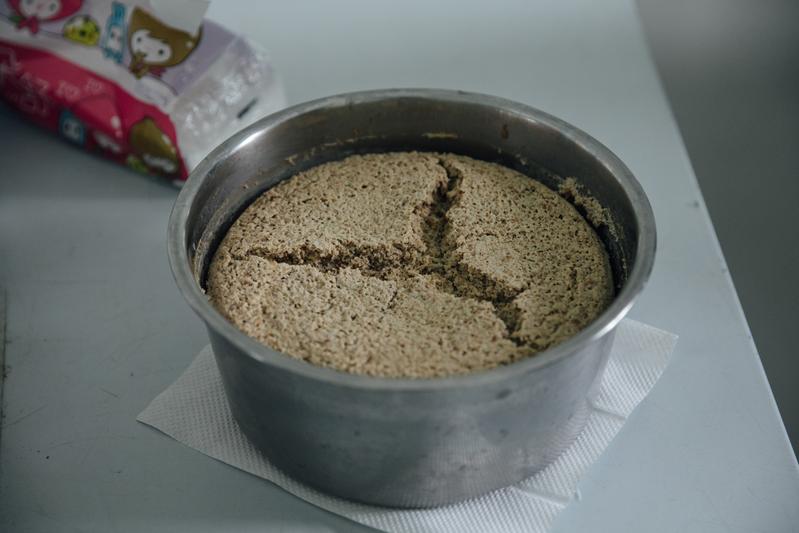
The precious pangolin diet recipe is delicious but costly. Its ingredients include bee pupa, mealworm, apple, egg, calcium carbonate, yeast, desiccated coconut, etc. The staff would blend these ingredients into a mud form, then steam it in an electric cooker, and the resulting food is named “pangolin cake.”
Although the Taipei Zoo has yet to find out the exact cause for pangolin's intestinal bleeding, the feeding situation has mostly been stabilized. In 1997, the zoo successfully bred its first pangolin, Fattie, and it has been healthy ever since. The fourth generation has been bred thus far.
The Taipei Zoo has shared its pangolin diet recipe with NPUST and the ESRI. When interviewed, the caregivers from both units presented similar recipes. NPUST even added the expensive Abbott nutritional supplement to better nurture the pangolins' health.
Despite being a world leader in pangolin conservation, Lo Hsuan-yi humbly admitted that the zoo has simply accrued more experiences rather than having discovered some pivotal techniques. “I still don't know enough,” she said.
She cited an example where pangolins are at critical risks when they switch from breastfeeding to synthetic feed, or when they are rescued from the wild and having to switch their diet. Rescue centers usually mix in formicaria found in the wilderness to lure the pangolins, but some of them would still fall ill from refusing to eat.
In the process of taking care of baby pangolins, Lo also keeps experimenting with new recipes. Since pangolins do not easily ingest their mother's milk, Chiung-wu was fed with cat milk while her child Wukong was fed with puppy formula. In the beginning, Chiung-Wu's scales were thinner and curlier than the wild pangolins; their colors were less glossy as well. Wukong's scales appeared healthier, but his skin was prone to eczema.
Lo and her coworkers are still looking for a solution to date. “Pangolins vary greatly in their body conditions so it's very complicated. Past experiences don't always apply and this is the biggest challenge in taking care of Wukong,” she said.
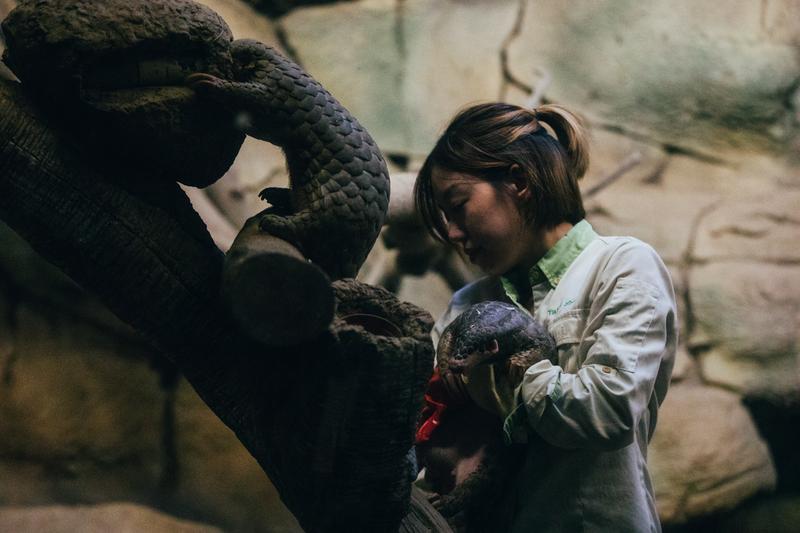
China's medical demands for pangolin scales almost led to the global extinction of pangolins. In China, pangolin scale consumption is legal for medical purposes, and domestic pangolin farms with government permits started to take shape. The Taipei Zoo, known for its pangolin conservation skills, became a pilgrimage for Chinese pangolin breeders.
However, media from the United States, Hong Kong, and even China itself have reported that Chinese pangolin farms have been purchasing illegally trafficked pangolin scales from Africa and Southeast Asia under the pretense of legality. These farms are often selling bred pangolin scales with the trafficked ones in the same mixture.
Well aware of the Chinese breeders' commercial greed, Lo always pays close attention to the people who seek to exchange pangolin conservation techniques. She would observe them, investigate their backgrounds through social networks, or even discuss with pangolin experts from the International Union for Conservation of Nature (IUCN) to determine how much knowledge she should share.
“Legal breeding poses tremendous difficulties and costs. Pangolins can only give birth once a year; each pregnancy lasts eight months, and newborn feeding requires six months. Within those six months, the mortality rate is high, and pangolin scales grow out very slowly. From a commercial standpoint, this sounds impossible,” Lo said.
Pangolin experts from around the world do not support confinement rearing. Aside from worrying about the abuse of legality, they also stress that pangolin scales are completely replaceable with other ingredients medically.
Although the zoo is feeding pangolins with the aim to rescue and conserve, it is still criticized for its intention to secure commercial gains. Lo admitted that the zoo needs to strike a balance between animal conservation and public display. The ultimate goal of breeding pangolins is to reintroduce them to wildlife, but the progress has yet to reach its final step. Taiwan's understanding of pangolins is still very limited, therefore, the current priority is to build a stable pangolin population.
Since pangolins live in burrows and their stools are difficult to analyze, wildlife study proves to be extremely difficult for experts around the globe.
It is necessary for the zoo to feed and breed pangolins, Lo stated. “We can't even find out the exact age of a pangolin since it has no teeth for us to examine,” she said.
If conservationists can find out the approximate age of a pangolin, then they can provide food and care much more precisely. To build the data file for pangolins, they have to instead observe their weight, tail length, body length, width, scales, and stools, etc.
Taipei Zoo had once collaborated with Lin Tsung-chi (林宗岐), a biology professor at the National Changhua University of Education who conducts research on ants. He examined the nutrients in the pangolin stool from the zoo and compared them to the stool collected in the field by NPUST's Wildlife Animal Shelter. Through the study, he analyzed the differences in their microbiotas and digestion rates in order to improve the pangolin recipe for the rescue centers.
Hsun Ching-min (孫敬閔), a longtime pangolin researcher and Ph.D. candidate in Bioresources at NPUST, has collaborated with the Taipei Zoo as well. Via stool analysis, he aimed to find out pangolins' digestion volume from ant consumption in order to calculate their nutritional intake.
He said it was impossible to figure out how much a wild pangolin has eaten, whereas the zoo could precisely monitor the volume of ants fed. By comparing the two, he could figure out the nutritional composition of the wild pangolin's diet.
“Captive breeding and field studies can complement each other,” Hsun said.
There is a total of 15 pangolins under the longterm care of Taipei Zoo, eight of which were bred in the zoo, while the other seven were injured in the wild and determined to be unsuitable for release. Although the zoo has tried its best to care for those injured pangolins, it cannot completely replicate the wildlife environment.
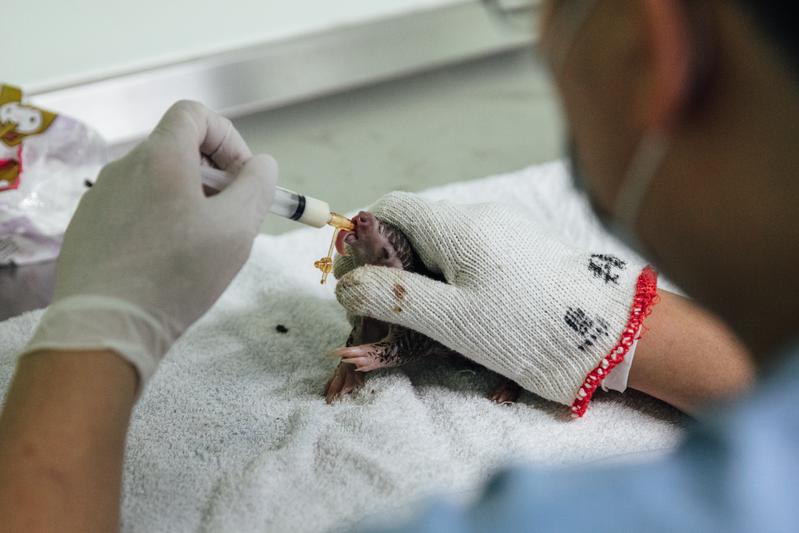
The most urgent challenge for pangolin conservation, then, is to minimize the chances of pangolins getting injured and being sent to the rescue centers.
In the ESRI's Animal First-aid Station, a newborn pangolin shares a similar fate with Chiung-wu. On the day of our interview, the newborn was delicately put in a vet's palm. Its pink body was covered in scales that were not yet hardened and its eyes were semi-closed as if it was still getting used to the world. But its tongue already knew how to lick the tube feeder by instinct.
After the meal, the vet gently stroked its back with two fingers to help with its digestion, like how humans burp their babies.
This pangolin was only 45-days old. Its mother was bitten by a stray dog before it was sent to the first-aid station.She gave birth to her baby with her last effort but failed to survive herself. The baby pangolin had to be placed in an insulated, burrow-like container at 60-percent humidity and 27°C. The vets took turns to be its nannies, and they are not yet certain whether it will be fit for release.
ESRI's Animal First-aid Station is the only pangolin rescue center that belongs to the Taiwanese government, receiving the most injury reports every year. As of the day of our interview (June 18), the first-aid station had seven pangolins in captivity: six adults and one baby. One of which was born in the station, another was injured while being caught in a net, the rest had all suffered attacks from stray dogs.
Between 1993 and 2009, ERSI estimated a total of 117 pangolins being sent to the rescue center, almost 70 percent of which were injured by beast traps. But now, stray dog attacks have replaced the beast traps, becoming the largest threat to pangolins.
Chan Fang-tse (詹芳澤), an associate researcher at the first-aid station, said that beast trap injuries have significantly decreased since the government banned them in 2011 and the public conservation awareness has been higher. Stray dog attacks have since become the top reason for pangolin injuries.
When pangolins are in danger, they would curl into a ball and use their hard scales to defend against their enemies, but dog bites are often far more violent. The pangolins arrive at the rescue center would often be missing a part of their tails.
One of the assignments for Tsai Yun-Ling (蔡昀陵), the first-aid station's wildlife rehab trainer, is “walking the pangolins.” He is often seen jogging behind a pangolin in training to follow it up and down the slopes and recording its movement with a smartphone. Tsai explains that a pangolin's tail is crucial to maintaining its balance; if it does not recover completely, its tail would drag on the ground or wiggle around, causing it to trip over a downward slope and diminishing its capabilities in the wilderness.
The only certainty is that stray dogs don't only attack pangolins, but also threaten other mammals.
Scholars from National Tsing Hua University, National Taiwan University, National Taiwan Normal University and National Chung Hsing University had set up an automated camera at Yangmingshan National Park (陽明山國家公園) for six years from 2012 to 2017. According to the Scientific Reports journal published in June 2019, they discovered that stray cats and dogs have changed the ecosystem for the native mammals in the park.
The study stated that the frequency of native mammals' appearances and the diversity of species are higher when they are far away from humans and dogs. Dogs have a bigger impact than human footprints; if stray dog activities exceed a certain threshold, the variety of mammal species would decline accordingly. This is Taiwan's first long-term scientific study to prove that stray dogs and cats do have an impact on native mammals. And Yangmingshan National Park is one of the most important habitats for pangolins.
Researchers urged the management units to control the population of stray dogs and cats, especially during the breeding season for native mammals and in areas with an abundance of small mammal species. They also stressed that pet owners should be responsible for training and keeping their pets on a leash, preventing injuries for wildlife animals. Chan Fang-tse also advised the public not to abandon their pets or feed any stray dog.
The baby pangolin in the first-aid station still needs to face more difficult challenges in the future: hunting for a formicary, staying away from humans, learning to avoid stray dogs that are wandering around. A series of wildlife training awaits.
Chan believes that pangolins still possess their survival instinct and their desire to roam free in nature, and their return to nature can only be secured if their habitats are kept healthy and safe.
(To read the Chinese version of this article, please click: 世界上最難養活的動物之一,台灣如何救傷穿山甲?)
深度求真 眾聲同行
獨立的精神,是自由思想的條件。獨立的媒體,才能守護公共領域,讓自由的討論和真相浮現。
在艱困的媒體環境,《報導者》堅持以非營利組織的模式投入公共領域的調查與深度報導。我們透過讀者的贊助支持來營運,不仰賴商業廣告置入,在獨立自主的前提下,穿梭在各項重要公共議題中。
今年是《報導者》成立十週年,請支持我們持續追蹤國內外新聞事件的真相,度過下一個十年的挑戰。

